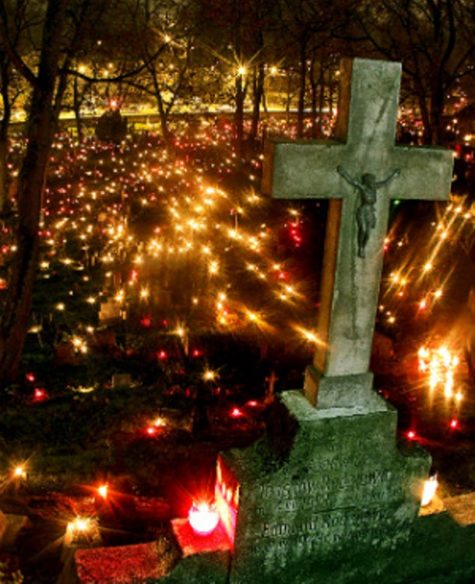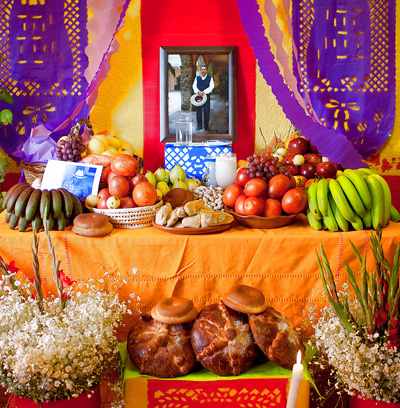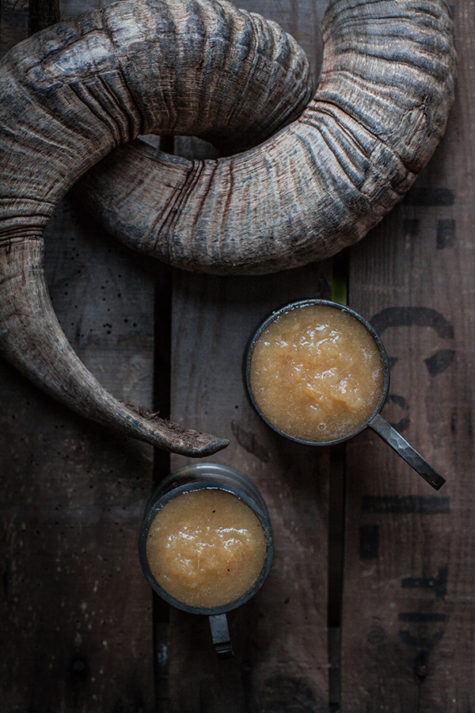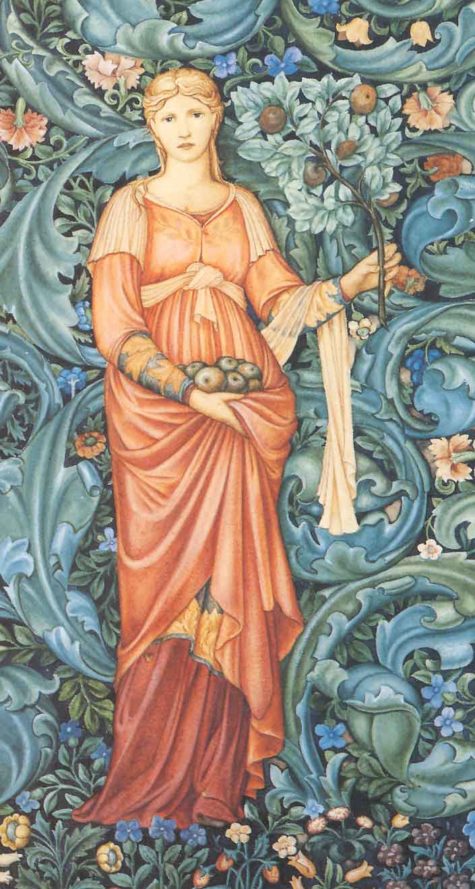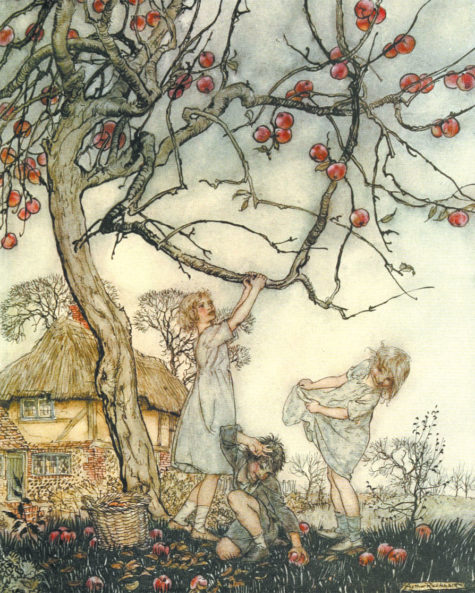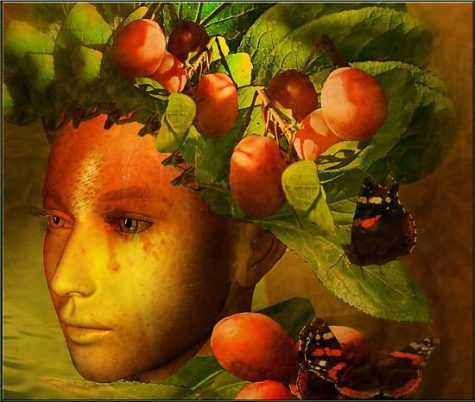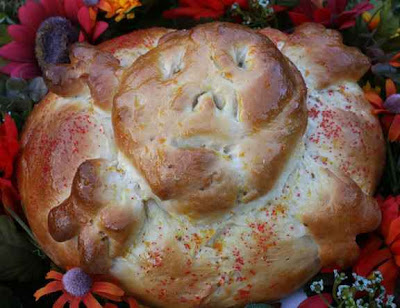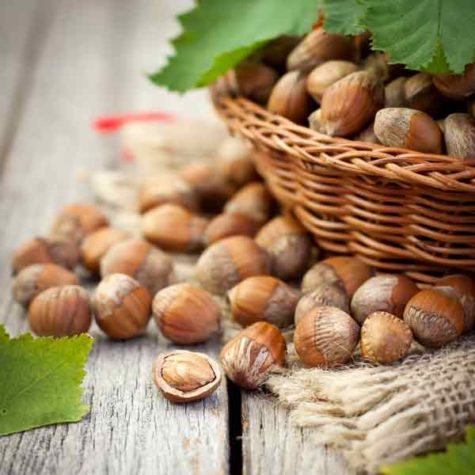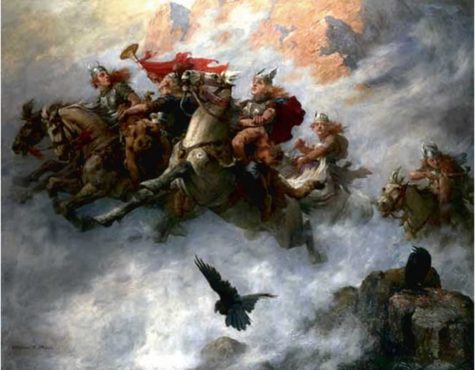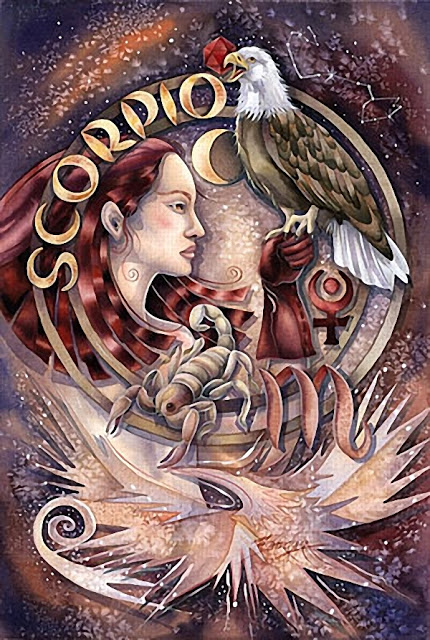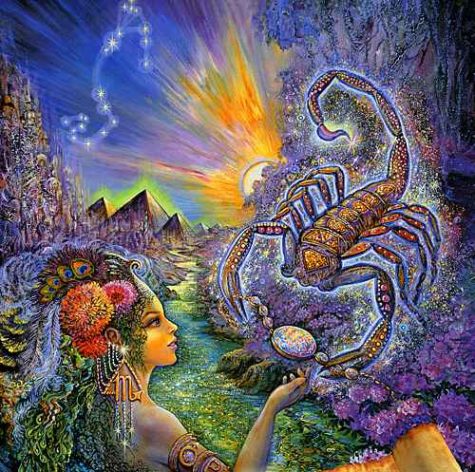As usual with big Catholic Feast days, food is involved with the day, with many Catholic families having picnics near their loved ones’ graves. Traditional foods include “Soul Food” — food made of lentils or peas.
Basic Split Pea Soup (serves 4)
- 1 cup chopped onion
- 2 cloves garlic (optional)
- 1 teaspoon vegetable oil or bacon grease
- 1 pound dried split peas
- 1 pound ham bone
- 1 c. chopped ham
- 1 c. chopped carrots (optional)
- salt and pepper to taste
In a medium pot, sauté onions in oil or bacon grease. (Optional: add garlic and sauté until just golden, then remove). Remove from heat and add split peas, ham bone and ham. Add enough water to cover ingredients, and season with salt and pepper.
Cover, and cook until there are no peas left, just a green liquid, 2 hours. (Optional: add carrots halfway through) While it is cooking, check to see if water has evaporated. You may need to add more water as the soup continues to cook.
Once the soup is a green liquid remove from heat, and let stand so it will thicken. Once thickened you may need to heat through to serve. Serve with either sherry or sour cream on top, and with a crusty bread.
There is a Mexican saying that we die three deaths: the first when our bodies die, the second when our bodies are lowered into the earth out of sight, and the third when our loved ones forget us.
Some believe that the origins of All Souls’ Day in European folklore and folk belief are related to customs of ancestor veneration practiced worldwide. It is practically universal folk belief that the souls of the dead (or those in Purgatory) are allowed to return to earth on All Souls Day. In Austria, they are said to wander the forests, praying for release. In Poland, they are said to visit their parish churches at midnight, where a light can be seen because of their presence. Afterward, they visit their families, and to make them welcome, a door or window is left open. In many places, a place is set for the dead at supper, or food is otherwise left out for them.
In any case, our beloved dead should be remembered, commemorated, and prayed for.
During our visits to their graves, we spruce up their resting sites, sprinkling them with holy water, leaving votive candles, and adorning them flowers (especially chrysanthemums and marigolds) to symbolize the Eden-like paradise that man was created to enjoy, and may, if saved, enjoy after death and any needed purgation.
Today is a good day to not only remember the dead spiritually, but to tell your children about their ancestors. Bring out those old photo albums and family trees! Write down your family’s stories for your children and grandchildren! Impress upon them the importance of their ancestors!
Traditional foods:
Around the world:
The formal commemoration of the saints and martyrs (All Saints’ Day) existed in the early Christian church since its legalization, and alongside that developed a day for commemoration of all the dead (All Souls’ Day). The modern date of All Souls’ Day was first popularized in the early eleventh century after Abbot Odilo established it as a day for the monks of Cluny and associated monasteries to pray for the souls in purgatory.
Many of these European traditions reflect the dogma of purgatory. For example, ringing bells for the dead was believed to comfort them in their cleansing there, while the sharing of soul cakes with the poor helped to buy the dead a bit of respite from the suffering of purgatory. In the same way, lighting candles was meant to kindle a light for the dead souls languishing in the darkness. Out of this grew the traditions of “going souling” and the baking of special types of bread or cakes.
In Tirol, cakes are left for them on the table and the room kept warm for their comfort. In Brittany, people flock to the cemeteries at nightfall to kneel, bareheaded, at the graves of their loved ones, and to anoint the hollow of the tombstone with holy water or to pour libations of milk on it. At bedtime, the supper is left on the table for the souls.
In Bolivia, many people believe that the dead eat the food that is left out for them. In Brazil people attend a Mass or visit the cemetery taking flowers to decorate their relatives’ grave, but no food is involved.
In Malta many people make pilgrimages to graveyards, not just to visit the graves of their dead relatives, but to experience the special day in all its significance. Visits are not restricted to this day alone. During the month of November, Malta’s cemeteries are frequented by families of the departed. Mass is also said throughout the month, with certain Catholic parishes organizing special events at cemetery chapels.
In Linz, funereal musical pieces known as aequales were played from tower tops on All Soul’s Day and the evening before.
In Mexico “Dia de Los Muertos” (Day of the Dead) is celebrated very joyfully — and colorfully. A special altar, called an ofrenda, is made just for these days of the dead (1 and 2 November). It has at least three tiers, and is covered with pictures of Saints, pictures of and personal items belonging to dead loved ones, skulls, pictures of cavorting skeletons (calaveras), marigolds, water, salt, bread, and a candle for each of their dead (plus one extra so no one is left out).
A special bread is baked just for this day, Pan de Muerto, which is sometimes baked with a toy skeleton inside. The one who finds the skeleton will have “good luck.” This bread is eaten during picnics at the graves along with tamales, cookies, and chocolate. They also make brightly-colored skulls out of sugar to place on the family altars and give to children.
Collected from various sources
On the first of November, it was an ancient Celtic practice to indulge in a sort of feast, which was called la mas ubhal, the day of the apple fruit, because on that occasion, roasted apples were bruised and mixed in ale, milk, or by those who could afford it, in wine. This is the origin of lamb’s wool.
About Lambs Wool:
The basic recipe for lambswool is as follows: Apples are roasted in a pan on the fire, or on a string over the fire, until they sizzle. They are then dropped, still hot, into the warmed, spiced, sweetened ale.
In Gerard’s Herbal (1633) it is described as a drink of warmed, spiced ale or cider, in which bob roasted apples: ‘sometimes, eggs or cream, or both, are whisked in, and sometimes it is served poured over small fruit cakes.’
It derives its name from the day which is dedicated to the Angel presiding over fruits and seeds, which was originally called “La Maso bal” which was corrupted to Lamb’s Wool. According to Nell Heaton writing in the late 1940’s. Alternatively, the name could simply be a reference to the fluffy appearance of the pulp of the roast apples, bobbing about in the warm brew.
From: The Scotish Gaël and Celebration
Pomona’s Day of Honoring is often cited as November 1, making it a close match to the Celtic holiday Samhain. But sometimes it’s cited as August 13. Taken together, those days bracket the apple season. The earliest dessert apples begin to ripen in late summer, while the last storage apples finish in late autumn.
Even before the Romans added Pomona to the Samhain festivities, the Celts traditionally roasted apples and nuts in the bonfires. Pomona’s associations strengthened the role and symbolism of this fruit in connection with the holiday. This may be the origin of the modern custom of “bobbing for apples.”
To do on Pomona’s Day:
- Plant an apple tree.
Trees set out during the autumn planting season have a chance for extra root growth before they leaf out in the spring. Invoking Pomona’s blessing for her favorite type of tree will help your apple sapling grow big and strong.
This is especially helpful for grafted trees, which are a little more fragile than self-rooted trees and can use a boost from the goddess of grafting.
- Do some divination.
Do divination or other magic with fruits and nuts. The seeds, peels, and flesh of fruiting plants are useful in many types of divination and spellcraft. At this time of year, the veil between worlds is thin, making divination easier and more effective.
Divination with apples includes such things as cutting the peel from an apple all in one strip and tossing it to reveal the initials of one’s future spouce, placing apple seeds on the coals to see if they lie quietly (fortelling a happy relationship) or fly apart (foretelling heartbreak), and cutting an apple in front of a mirror to scry one’s beloved.
- Practice some Apple Magick.
Another set of practices draws on the apple’s qualities as a magickal fruit with power over the otherworld. These rituals deal with death and banishing. An apple may be cut in half and buried to cure a disease, settle a quarrel, or break a bad habit. Apples are also sometimes thrown to drive away evil spirits, or left out to feed the spirits of the dead so they do not trouble the living.
Ritual for Pomona’s Day
Here is a nice little ceremony to honor Pomona on her day:
- Colors: Red, yellow, green
- Earth
- Altar: Upon cloth of any or all of these colors, lay baskets of apples (preferably the old Roman variety “Lady”)and other tree fruit, a jug of cider, and a pruning knife.
- Offerings: Water fruit trees.
- Daily Meal: Vegetarian, with any food made with apples.
Invocation to Pomona
Lady of the Apple Tree
Whose red-cheeked visage greets the dawn,
Lady of the Pear Tree
Whose sweetness salves the questing tongue,
Lady of the Peach Tree
Whose blush transforms the morning sky,
Lady of the Plum Tree
Whose scent entices, smooth and smiling,
Lady of the Cherry Tree
Whose scarlet lips are drenched in raindrops.
Lady of the blossoming branch
Who entices bees to dance with you,
Lady of the secret orchard
Where Vertumnus gained his entry,
Where he came in secret, clothed in
Vestments of the ancient Crone,
God of growth, god of seasons,
God of turning, he took you there
As you offered up your nectar
And all the trees above you burst their buds.
Lady of the ancient ones, the Trees
Who give forth their children one by one
That we may know not just mere survival
But sweetness as well, help us to remember
The beauty and abundance of your gifts.
Chant:
Pomona Pomona
Pomum Pirum Prunus
Pax Pactum Promissio
Sources:
The Mourning Moon is upon us. As the days grow shorter and the sun’s life-giving fires are banked, sometimes it seems so dark we feel the light will never return. This moon, however, is a reminder that death is just a part of the endless cycle of life, death, and rebirth.
It’s also known as the Fog Moon or Snow Moon, depending on where you live. Some Native American tribes referred to it simply as The Moon When Deer Shed Antlers (although in most regions it’s more accurate to say they’re shedding their velvet – a buck doesn’t usually lose antlers until later in the winter, unless you’re very far north).
Correspondences:
- Colors: Gray, blues
- Gemstones: Lapis lazuli, turquoise, topaz
- Trees: Cypress, alder, hazel
- Gods: Bastet, Isis, Kali, Hecate, Astarte
- Herbs: Thistle, betony, verbena, fennel
- Element: Water
In the early Celtic society, November was the beginning of the new year, and so it makes sense to use the magic of this moon phase to celebrate new beginnings.
This is a time of washing away the baggage of the past and letting it go. Once you’ve done that, you’ll be able to focus on the joys of the future. During the Mourning Moon phase, say goodbye to bad habits and toxic relationships, and get a fresh start for the new year. Work on developing and strengthening your connection with Spirit.
The pan de muerto (Spanish for Bread of the Dead or Day of the Dead Bread) is a type of bread from Mexico baked during the Dia de los Muertos season, around the end of October and the official holiday is celebrated on November 2. It is a soft bread shaped in round loaves with strips of dough attached on top (to resemble bones), and usually covered or sprinkled with sugar.
Another bread in the form of a sphere on the top represents a skull. The classic recipe for Pan de Muerto is a simple sweet bread recipe with the addition of anise seeds.
Pan de Muerto is sometimes baked with a toy skeleton inside. The one who finds the skeleton will have “good luck.” This bread is eaten during picnics at the graves along with tamales, cookies, and chocolate.
Ingredients:
- 1/4 cup milk
- 1/4 cup (half a stick) margarine or butter, cut into 8 pieces
- 1/4 cup sugar
- 1/2 teaspoon salt
- 1 package active dry yeast
- 1/4 cup very warm water
- 2 eggs
- 3 cups all-purpose flour, unsifted
- 1/2 teaspoon anise seed
- 1/4 teaspoon ground cinnamon
- 2 teaspoons sugar
Instructions: Bring milk to boil and remove from heat. Stir in margarine or butter, 1/4 cup sugar and salt.
In large bowl, mix yeast with warm water until dissolved and let stand 5 minutes. Add the milk mixture.
Separate the yolk and white of one egg. Add the yolk to the yeast mixture, but save the white for later. Now add flour to the yeast and egg. Blend well until dough ball is formed.
Flour a pastry board or work surface very well and place the dough in center. Knead until smooth. Return to large bowl and cover with dish towel. Let rise in warm place for 90 minutes. Meanwhile, grease a baking sheet and preheat the oven to 350 degrees.
Knead dough again on floured surface. Now divide the dough into fourths and set one fourth aside. Roll the remaining 3 pieces into “ropes.”
On greased baking sheet, pinch 3 rope ends together and braid. Finish by pinching ends together on opposite side. Divide the remaining dough in half and form 2 “bones.” Cross and lay them atop braided loaf.
Cover bread with dish towel and let rise for 30 minutes. Meanwhile, in a bowl, mix anise seed, cinnamon and 2 teaspoons sugar together. In another bowl, beat egg white lightly.
When 30 minutes are up, brush top of bread with egg white and sprinkle with sugar mixture, except on cross bones. Bake at 350 degrees for 35 minutes.
Makes 8 to 10 servings.
Recipe found at: AzCentral
Early divination was often done using only the items at hand — sticks, vegetable peels, cloud formations, etc. Around the end of the harvest season, there wasn’t often much left in the fields.
However, nuts were often plentiful. Pecans, chestnuts, filberts and more would have been gathered up in baskets and stored, which made them the perfect medium for late fall divination. This is a similar celebration to Nutting Day, which falls in mid-September.
Filberts are the European variety of hazelnuts, and in some parts of England, they were used for divination purposes around Samhain night. In fact, for a while the practice was so popular that Halloween was sometimes referred to as Nut Crack Night. Filberts were placed in a pan over a fire and roasted. As they heated up, they would pop open. Young women watched the filberts carefully, because it was believed that if they popped enough to jump out of the pan, romantic success was guaranteed.
In some areas of Europe, the nuts were not roasted, but instead were ground into flour, which was then baked into special cakes and dessert breads.
These were eaten before bed, and were said to give the sleeper some very prophetic dreams. In a few regions, the flour was blended with butter and sugar to create Soul Cakes for All Soul’s Night.
Scottish poet Robert Burns describes a practice in which couples would roast a pair of nuts together, and the behavior of the nuts was indicative of the future of the relationship.
Burns says, “Burning the nuts is a favourite charm. They name the lad and lass to each particular nut, as they lay them in the fire; and accordingly as they burn quietly together, or start from beside one another, the course and issue of the courtship will be.”
Want to do your own Nut Crack Night divination? Select a pair of uncooked filberts. Assign a name to each for you and your lover. Place them in a pan over a fire, and watch to see what they do. Nuts that fly apart indicate that the relationship won’t last, but if they stay together, you’re practically guaranteed to be happy!
by Patti Wigington, ThoughtCo.com
Today is the Feast of the Einherjar: The chosen heroes who sit in Odin’s Hall are the Einherjar. Today we honor those dead kin who gave their lives for Family and Folk. If you have friends or family who died in battle, visit their graves today, if that is not possible, drink a libation in their memory.
- See also: Honoring the Einherjar
Note: Also called Fogmoon, this feast day is held on the nearest weekend to November 1st. A celebration of the war-dead and of Ragnarok, it is dedicated to Odin and Freya.
Scorpio is the eighth sign of the zodiac. The sun enters Scorpio at slightly different times each year, usually around Oct 22, sometimes the day before or the day after.
- Symbol: Scorpion
- Element: Water
- Gemstone: Topaz
- Keword: I Desire
Scorpios are forceful, determined, secretive, and emotional. They are naturally intuitive, and instinctively know what makes other people work. However, they keep their own motivations and true nature a secret. Scorpios are patient people who wait for opportunities and then act quickly, using surprise to their benefit. Scorpios usually know what they want, and they invariably achieve their goals in the end.
From 365 Goddess, we have this for today:
- Themes: Creativity; Sexuality; Passion; Instinct; Fire; Energy
- Symbols: Scorpion (or any stinging, hot items)
- Presiding Goddess: Isara
About Isara:
An ancient Mesopotamian goddess, Isara is known for her fiery nature. The Syrians specifically worshiped her in the form of a scorpion when they wished to improve sexual prowess or passion. In other traditions, Isara judges human affairs fairly but firmly, and all oaths made in her name are sacred.
To Do Today:
In astrology, people born under the sign of Scorpio are said to be creative, tenacious, sturdy, and sensuous, often internalizing Isara’s fire in their sign for personal energy. To do likewise, enjoy any hot beverages (such as coffee with a touch of cinnamon for vitality) first thing in the morning. This will give you some of Isara’s fire to help you face your day, both mentally and physically.
For those wishing to improve interest or performance in the bedroom, today is a good time to focus on foods for passion and fecundity. Look to bananas or avocados in the morning, olives, dill pickles, radishes, or licorice sticks as a snack, beans as a dinner side dish, and shellfish as a main platter. Remember to invoke Isara’s blessing before you eat. And, if you can find one, put the image of a scorpion under your bed so that Isara’s lusty nature will abide in the region and you can tap into it during lovemaking.
More About the Sun in Scorpio
The Sun is in Scorpio from approximately October 23 to November 21, depending on the year.
- Ruler: Pluto, Mars
- Modality: Fixed
- Season: Fall
- Metal: Steel, Iron
- Stone: Topaz, Opal
- Color: Gold, Purple
- Flowers: Chrysanthemum; Pansy
- Anatomy: Genital organs, bladder, bowels
- Attributes: passionate, perceptive, resourceful, possessive, psychological, prowling, determined, probing, fixed, focused.
Scorpios are known for their intensity. They are determined folk that absolutely throw themselves into whatever they do — but getting them to commit to something is rarely an easy task. In fact, it’s better not to even try to “get them” to do anything. Solar Scorpios absolutely have their own mind. And, their primary motivation is unlikely to be prestige (like their Capricorn friends), or even authority (Leos can have that, too)–it’s real power. Their power can absolutely be of the “behind the scenes” variety, just as long as they have it.
To others, Scorpios seem to have plenty of willpower. They probably do. Scorpios do know what they want, and they won’t go out and grab it at the wrong moment. They simply sit back, watch (quite expertly), and then get it only when the moment is just right. This apparent patience is simply their powerful skills at strategy at work.
Scorpio isn’t afraid of getting their hands (their bodies, their minds) dirty. The darker side of life intrigues them, and they’re always ready to investigate.
Scorpios simply never give up. They have tremendous staying power. They’re not in the slightest intimidated by anybody or anything. Confrontations are not a problem. In fact, talk to any Scorpio about their lives, and you’ll probably be in awe at all they’ve gone through. Trauma seems to follow them wherever they go. When Scorpio learns optimism, instead of expecting the worst, they’ll find that they possess amazing regenerative powers — the power to heal, create, and transform.
Source: Cafe Astrology
Lovely, summer-like days that occur around October 18 are called St. Luke’s Little Summer in honor of the saint’s feast day. In olden days, St. Luke’s Day did not receive as much attention in the secular world as St. John’s Day (June 24) and Michaelmas (September 29), so to keep from being forgotten, St. Luke presented us with some golden days to cherish before the coming of winter, or so the story goes. Some folks call this Indian Summer, but that officially occurs between November 11 and November 2
Traditional Catholic Celebrations:
Saint Luke’s Feast Day can be celebrated by reading the Acts of Apostles and praying the three canticles he preserved for us – the Benedictus, the Magnificat and the Nunc Dimittis. As the first Christian physician, Saint Luke is the patron saint of physicians and surgeons. For this reason, we honor Saint Luke on his feast day by praying through his intercession for doctors and those who care for the sick.
Found at: Almanac.com

